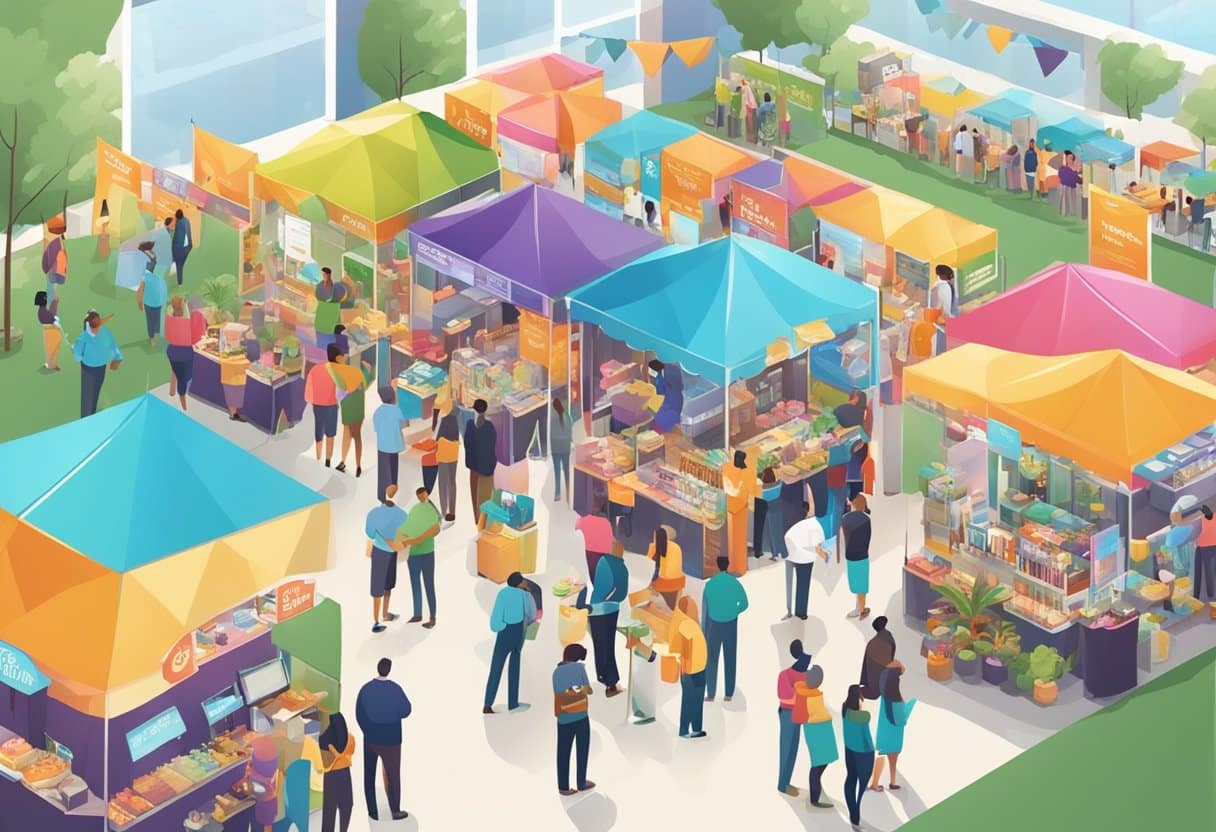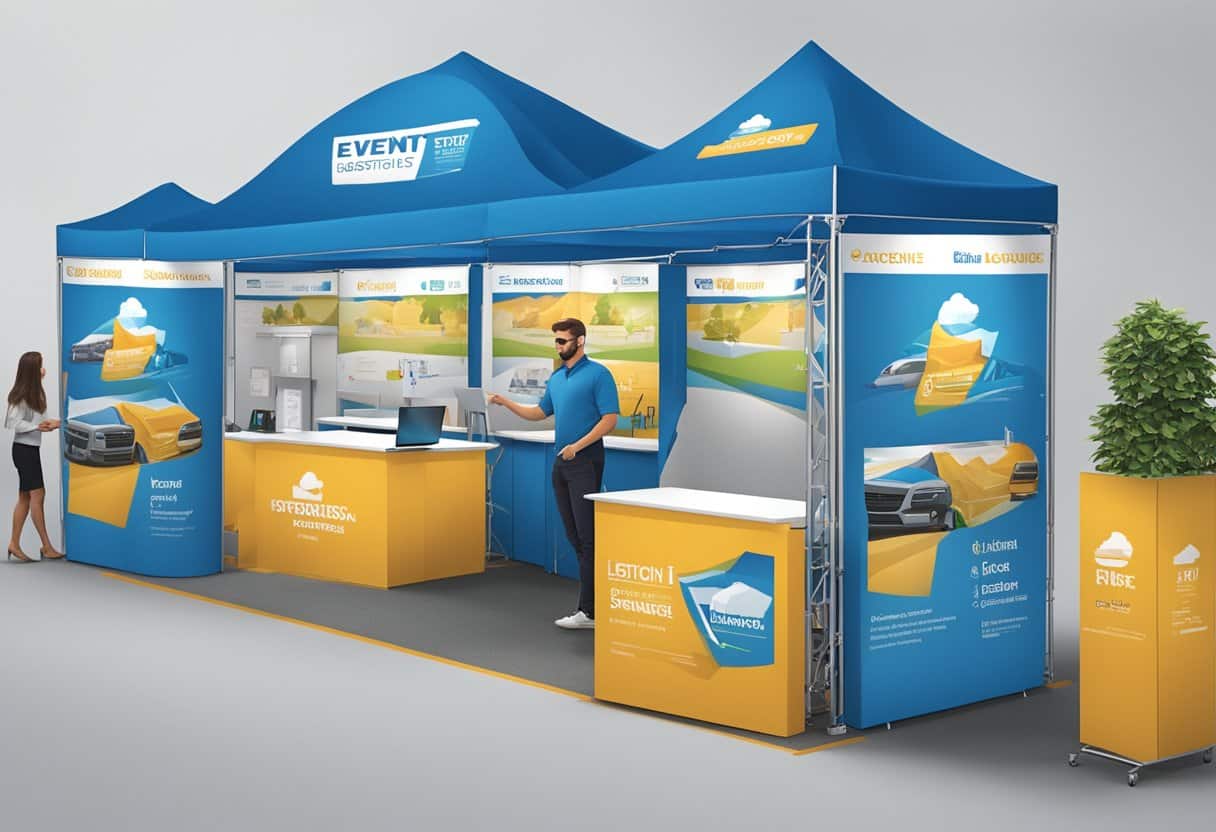Event Booths: Maximizing Engagement at Your Next Conference
Event booths serve as a central hub for companies to showcase and promote their products or services and engage with attendees at trade shows, conferences, and other types of events. These booths are an essential element for any brand looking to increase awareness in a competitive space, operate as a physical representation of the brand, and provide an immersive experience for visitors. Their design and presentation can play a pivotal role in attracting potential customers and leaving a lasting impression.

Creating an effective event booth involves careful planning, from initial concept to the final setup on the event day. Companies must consider a variety of factors, such as booth location, branding elements, and the target audience, to optimize their reach and impact. A well-designed booth not only spotlights a company’s products or services but also facilitates better engagement strategies, making it an invaluable tool for establishing connections and building business relationships.
Key Takeaways
Event booths are critical for driving brand awareness and engagement at trade shows.
Strategic design and planning are vital to make a booth effective and memorable.
The booth execution, from logistics to follow-up, influences the overall success of event participation.
Designing Your Event Booth

Designing an event booth that effectively showcases a brand requires careful consideration of display type, creative components, and visitor engagement strategies. Incorporate elements that align with the company’s marketing goals and brand image, while also considering the latest innovations, functionality for attendees, and sustainable practices.
Choosing the Right Type
Selecting the optimal booth type is crucial for maximizing both visibility and attendee interaction. An inline booth offers a cost-effective solution for exhibitors with limited space, while a corner booth typically enjoys increased traffic due to dual-side exposure. For a more open and inviting layout, a peninsula booth provides access on three sides. The most immersive experience is granted by an island booth, which stands alone and offers 360-degree accessibility.
Creative Elements
To ensure your booth stands out, infuse creative and unique design elements into sign display that captivate visitors. Employ an element of surprise such as unexpected visual effects or interactive experiences. High-impact visual marketing can be achieved with bold graphics and high-resolution images to attract attention from afar.
Engaging Display Ideas
Engage attendees with hands-on product demos to showcase the practical applications of your offerings. Consider incorporating an interactive booth feature, such as projection mapping, to create a dynamic and memorable experience. For added fun, a live band or a prize wheel can keep visitors entertained and engaged.
Branding and Marketing
Utilize consistent branding across all aspects of your booth, from the logo to the color scheme. Display the company logo prominently, and ensure all products and services are associated with the brand’s key messages. Booth furniture, graphics and other signs and signages should clearly convey the brand’s vision and values.
Innovations and Trends
Embrace current trends such as virtual trade show elements or interactive features that can extend the reach beyond physical attendees. Incorporating augmented reality can offer an innovative way for brands to demonstrate products or services to a tech-savvy audience.
Functionality and Comfort
To enhance the visitor experience, booth displays should provide amenities such as seating, charging outlets, and free water bottles. Ensure there is enough seating space to allow attendees to rest and engage comfortably with the booth displays and staff.
Sustainability Practices
Commit to environmental responsibility by constructing the exhibition booth from wood or other eco-friendly materials. Integrating sustainable practices into exhibits, like using recyclable materials and minimizing waste, reflects positively on the brand’s commitment to sustainability.
Event Logistics and Setup

When planning for trade show booths or exhibition of trade show booths, understanding the logistics and setup process is critical to success. This involves strategic exhibit booth and location selection, effectively partnering with sponsors, and ensuring a smooth preparation and assembly process.
Booth Location Strategies
Booth location within a trade show can significantly impact foot traffic and engagement levels. When choosing a location, exhibitors should prioritize high-traffic areas close to entrances, food courts, or alongside prominent pathways. Corner booths may offer increased visibility due to multiple open sides. It’s also important to consider proximity to key competitors and complementary businesses, leveraging the chance for cross-promotion.
Partnering with Sponsors
Partnering with sponsors can elevate the effectiveness of an event display. When selecting a partner, one must ensure alignment of brand values and target audiences to create a cohesive experience for customers. Formal agreements should outline the display and messaging requirements, co-branding opportunities, and resource sharing to maximize the visibility and impact of the displays for both parties.
Preparation and Assembly
The preparation and assembly of an exhibition booth is a process that benefits greatly from careful planning and attention to detail. Timelines should include deadlines for design approvals, production, and shipment of materials. A checklist for on-site assembly can streamline the setup, which includes:
Layout: Detailed floor plans and diagrams
Materials: Inventory of all display pieces
Tools: Necessary equipment for construction
Staff: Assigned roles for efficient workflow
Utilizing these strategies, those involved in event logistics can ensure their next event, exhibition or trade show booth is optimally positioned, well-partnered, and seamlessly assembled.
Attendee Engagement Strategies

For event booths to successfully generate leads and foster a strong brand message, they must captivate trade show attendees through compelling interactions, strategically designed promotional tactics, and enriching educational opportunities.
Interactive Activities
Interactive elements provide pivotal opportunities for engagement and networking. Photo opportunities serve as a memorable draw for visitors, effectively merging fun with the event’s overarching theme. For example, engaging attendees with a raffle or free giveaways not only boosts traffic to the booth but also creates a buzz, driving further interest and potential lead generation. Tagprints advises on an Active Approach to Booth Staffing to increase booth visitors and engagement.
Promotional Tactics
The distribution of swag, with careful consideration to item choice, can leave a lasting impression of a brand’s message and identity. By offering a wide selection of unique, attractive and desirable items, trade show attendees are more likely to visit and remember a booth. Employing social media as a promotional tool, as endorsed by Tagprints, can amplify the event’s reach and maximize engagement at a conference booth.
Educational Opportunities
Educational touchpoints such as workshops and seminars offer significant value to trade show booths and attendees. They not only enhance attendee knowledge but also position the exhibiting booth as a thought leader within the industry. Events designed around education pave the way for deeper discussions, facilitating valuable networking opportunities, as highlighted by Cvent’s ideas on building an Attendee Engagement Strategy.
Product and Service Highlighting

Event booths are powerful tools for showcasing and exhibiting what’s new and exciting in a company’s portfolio. From revealing and promoting the latest products to demonstrating services, these dedicated spaces are optimized to capture attendee attention and offer unique, event-only promotions.
New Product Unveiling
New products are often the heart of an event booth, with product launches designed to generate buzz. Companies strategically plan their trade show presence around these unveils, often investing in high-impact signage and display systems to ensure their latest innovations are seen. For instance, new tech gadgets might be encased in glass, with live feeds broadcasting their features to screens around the booth.
Feature Spotlights:
Sleek Display Cases
High-Definition Feature Videos
Service Demonstrations
When it comes to services, live demonstrations can connect potential clients to a brand’s offerings in a very tangible way. Specialized staff are present to showcase the ins and outs of a service, addressing questions and guiding through typical scenarios. This hands-on approach can elevate a brand’s credibility and showcase their expertise in real-time.
Demonstration Essentials:
Trained Specialists
Interactive Presentations
Exclusive Offers
Trade shows are unique for providing exclusive offers that are not typically available elsewhere. These can be special promotions, discounts on services, or early access to new products. These trade show exclusives are advertised with bold visuals and often a countdown or ticker to emphasize and highlight the limited nature of the offer.
Exclusivity Tactics:
Limited-time Discounts
Early Access Sign-ups
Post-Event Follow-Up
Effective post-event follow-up is crucial for capitalizing on the connections made at an event. It allows exhibitors to analyze visitor interactions and implement lead nurturing strategies that can boost their return on investment.
Analyzing Visitor Data
Visitor analytics play an integral role in post-event follow-up. Exhibitors should collect data on booth visits, attendee engagement, and material downloads. Tools like RFID tracking can provide insights into the behavior of visitors, which then helps in understanding what worked well and what did not. This data should be compiled into a report that highlights key metrics such as:
Total booth visitors
Peak visit times
Average engagement duration
Lead Nurturing and Outreach
After the event, lead nurturing becomes a primary focus. This begins with timely thank-you emails to express appreciation for attendees’ interest. These emails should be personalized and may include highlights from the event or additional resources.
For more direct engagement, follow-up calls are effective in furthering the conversation with potential leads. They offer a personal touch and can quickly qualify the interest level of the leads. A succinct call script might look like this:
Thank the person for visiting the booth.
Recap any special moments or discussions that took place.
Discuss the attendee’s needs and how your offerings align.
Schedule a meeting or send additional information as warranted.
Feedback collection is also essential, as it provides valuable insights into the attendee experience, which can be used to improve future events and follow-up strategies.
Frequently Asked Questions
When approaching the design and execution of event booths, many exhibitors have questions regarding optimization and effectiveness. This section aims to clarify some of the common queries.
How can one effectively design a trade show booth to attract visitors?
Effective trade show booth design hinges on clarity, brand consistency, and interactivity. A team considering purchasing a new booth should ask specific questions to ensure the design reflects their brand and meets their trade show goals.
What are the essential components of a portable trade show display?
A portable trade show display must be lightweight, easy to assemble, and durable. Essential components of trade show displays include modular elements, high-quality graphics, and flexible design features that adapt to different exhibit spaces.
What factors should be considered when selecting a company for trade show booth construction?
When selecting a company for trade show exhibit booth construction, consider their experience, portfolio of past work, customer service, and their ability to provide customizable solutions in line with the exhibitor or shop trade show’s vision.
How to budget for the costs associated with participating in a trade show?
Budgeting for a trade show involves accounting for booth design, construction, transportation, staff training, and ancillary expenses such as promotional print materials. It’s key to early planning and understanding all potential costs to avoid unexpected expenditures.
What are the different types of trade show display banners available and their benefits?
Trade show displays and display banners vary from retractable and pop-up banners to backdrop and hanging banners. Each has benefits, such as ease of setup or eye-catching height, and are chosen based on the exhibitor’s space and brand visibility goals.
What techniques enhance audience engagement in event booth setups?
To enhance audience engagement, interactive elements like touchscreens displays, product demonstrations, and engaging decor should be integrated into the marketing event and booth setup. Creative activities that resonate with the brand can significantly increase visitor interaction.
